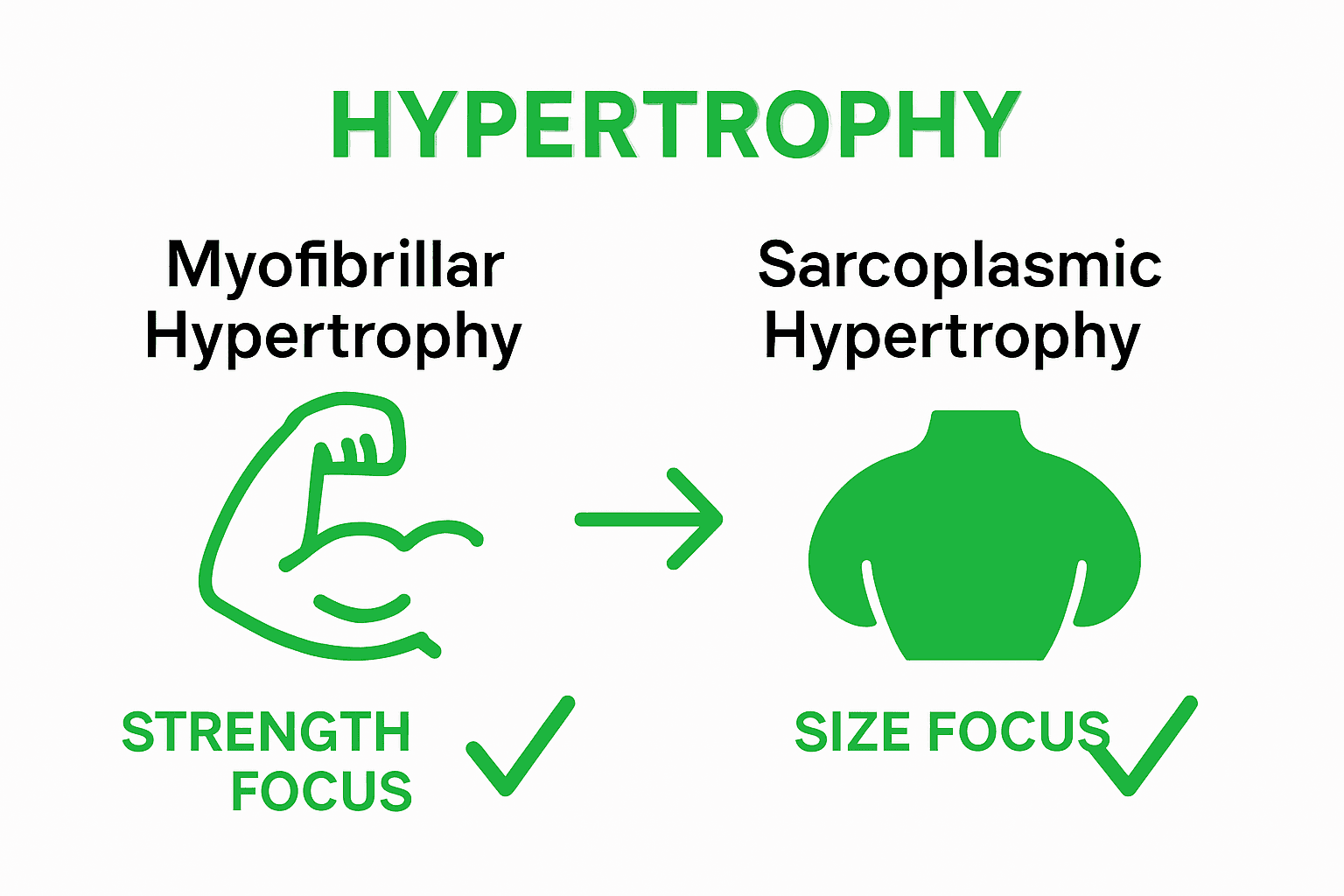Muscle hypertrophy is often seen as just getting bigger muscles from lifting heavy weights. Yet studies show it does much more, with increased muscle mass directly improving insulin sensitivity and joint stability. Surprisingly, muscle size alone is not the real indicator of strength or health. The real magic lies in how muscle growth changes metabolism and protects you from age-related decline.
Table of Contents
- Defining Muscle Hypertrophy And Its Importance
- The Science Behind Muscle Growth
- Factors That Influence Muscle Hypertrophy
- Types Of Muscle Hypertrophy: Myofibrillar Vs. Sarcoplasmic
- Real-World Applications And Implications Of Muscle Hypertrophy
Quick Summary
| Takeaway | Explanation |
|---|---|
| Muscle hypertrophy enhances physical performance. | Increased muscle size supports strength, power, and endurance in various athletic pursuits. |
| Resistance training is vital for muscle growth. | Mechanical tension from weightlifting stimulates muscle adaptations through cellular responses. |
| Nutrition is essential for optimal hypertrophy. | Adequate protein and hormonal support enhance muscle protein synthesis and recovery processes. |
| Understanding training variables optimises results. | Adjusting load intensity, volume, and frequency directly impacts muscle growth effectiveness. |
| Two types of hypertrophy exist: myofibrillar and sarcoplasmic. | Myofibrillar focuses on strength, while sarcoplasmic emphasises muscle volume and size increase. |
Defining Muscle Hypertrophy and Its Importance
Muscle hypertrophy represents a fundamental biological process where muscle fibres increase in size through specific physiological adaptations. Understanding this process is crucial for individuals seeking to enhance physical performance, improve body composition, and develop strength. Research from the National Institutes of Health indicates that muscle hypertrophy occurs primarily as a response to mechanical stress placed on muscle tissues during resistance training.
The Biological Mechanisms of Muscle Growth
At its core, muscle hypertrophy involves complex cellular mechanisms triggered by resistance exercise. When muscles are subjected to significant mechanical tension through weightlifting or resistance training, microscopic damage occurs within muscle fibers. This damage initiates a sophisticated repair and adaptation process where satellite cells surrounding muscle tissues become activated.
These satellite cells play a critical role in muscle growth by:
- Donating nuclei to muscle fibers
- Supporting protein synthesis
- Facilitating muscle fiber reconstruction
Why Muscle Hypertrophy Matters
Beyond aesthetic improvements, muscle hypertrophy contributes significantly to overall physiological health. Increased muscle mass supports metabolic function, enhances insulin sensitivity, and improves joint stability. For athletes and fitness enthusiasts, understanding muscle hypertrophy means developing targeted training strategies that promote optimal muscle development.
Moreover, muscle hypertrophy is not just about size but functional capacity. Our comprehensive guide on muscle protein synthesis provides deeper insights into the underlying mechanisms that support muscle growth and repair. By comprehending these intricate biological processes, individuals can design more effective training programmes that maximize muscle development and overall physical performance.
The Science Behind Muscle Growth
Muscle growth is a sophisticated biological process driven by intricate physiological mechanisms that transform cellular responses to mechanical stress. Research from the National Institutes of Health reveals that muscle hypertrophy emerges through three primary scientific pathways: mechanical tension, metabolic stress, and muscle damage.
Cellular Adaptation Mechanisms
When muscles encounter significant resistance during exercise, they experience microscopic trauma that triggers a complex repair and growth response. This process involves multiple cellular signalling pathways, with the mammalian target of rapamycin (mTOR) playing a crucial regulatory role. The mTOR pathway acts as a molecular sensor, detecting mechanical stress and initiating protein synthesis mechanisms that ultimately lead to muscle fiber enlargement.
The key cellular processes involved include:
- Activation of satellite cells surrounding muscle tissue
- Increased protein synthesis rate
- Enhanced muscle protein breakdown and reconstruction
Hormonal Influences on Muscle Development
Hormonal interactions significantly contribute to muscle growth, with testosterone, growth hormone, and insulin-like growth factors acting as primary anabolic drivers. These hormones interact synergistically to promote protein synthesis, reduce protein breakdown, and stimulate satellite cell proliferation.
Interestingly, muscle growth is not solely dependent on exercise intensity but also nutrition and recovery strategies. Learn more about lean muscle development to understand how nutritional interventions can complement resistance training for optimal muscle adaptation. Understanding these scientific principles empowers athletes and fitness enthusiasts to design more targeted and effective training programmes that maximise muscle growth potential.
Factors That Influence Muscle Hypertrophy
Research from the National Institutes of Health highlights that muscle hypertrophy is a complex process influenced by multiple interconnected factors. Understanding these variables enables individuals to optimise their training strategies and maximise muscle growth potential.
Training Variables and Mechanical Stimulation
Resistance training represents the primary driver of muscle hypertrophy. The specific parameters of training significantly impact muscle growth, with key determinants including training intensity, volume, and frequency. Higher resistance loads that challenge muscle groups beyond their current capacity stimulate more substantial cellular adaptations.
Critical training variables include:
- Load intensity relative to individual maximum strength
- Number of sets and repetitions per muscle group
- Rest intervals between training sessions
- Exercise selection and movement complexity
Nutritional and Physiological Considerations
Muscle growth extends beyond mechanical stress, requiring comprehensive nutritional support. Protein intake plays a crucial role in providing amino acids necessary for muscle protein synthesis. Consuming adequate protein quantities distributed throughout the day optimises the body’s muscle-building potential.
Hormonal environments also dramatically influence muscle hypertrophy. Testosterone, growth hormone, and insulin-like growth factors create an anabolic state that promotes muscle tissue development. Learn more about muscle memory and its role in long-term adaptation to comprehend how consistent training influences physiological responses.
Genetic factors additionally modulate individual muscle growth responses, explaining why some individuals experience more rapid or pronounced muscle development compared to others. Recognising these personal variations helps design more personalised and effective training approaches.
This table outlines the main factors influencing muscle hypertrophy as highlighted in the article, allowing readers to see the multi-faceted nature of optimal muscle growth.
| Factor | Role in Muscle Hypertrophy |
|---|---|
| Training Intensity | Higher loads stimulate greater muscle adaptation |
| Training Volume | More sets and repetitions promote muscle growth |
| Training Frequency | Regular stimulation aids ongoing adaptation |
| Protein Intake | Supplies amino acids vital for muscle protein synthesis |
| Hormonal Environment | Anabolic hormones drive muscle growth responses |
| Recovery Strategies | Rest allows for effective repair and muscle adaptation |
| Genetic Predisposition | Individual genetics influence rate and degree of muscle development |

Types of Muscle Hypertrophy: Myofibrillar vs. Sarcoplasmic
Research from Exercise Physiology reveals that muscle hypertrophy is not a singular process, but encompasses two distinct types of muscle growth: myofibrillar and sarcoplasmic hypertrophy. Understanding these variations is crucial for designing targeted training strategies that align with specific fitness objectives.
Myofibrillar Hypertrophy: Strength Development
Myofibrillar hypertrophy represents a more profound cellular adaptation focused on increasing muscle contractile capacity. In this process, the number and size of myofibrils within muscle fibers dramatically increase. Myofibrils are the protein filaments responsible for muscle contraction, meaning this type of hypertrophy directly translates to enhanced muscular strength and power output.
Key characteristics of myofibrillar hypertrophy include:
- Significant increases in muscle fiber density
- Enhanced neural recruitment of muscle motor units
- Improved maximum force production capabilities
- Greater potential for strength development
Sarcoplasmic Hypertrophy: Muscle Volume Expansion
In contrast, sarcoplasmic hypertrophy involves an increase in the muscle cell’s non-contractile fluid and supporting components. This type of muscle growth primarily contributes to muscle volume and visual size enhancement rather than direct strength improvements. Bodybuilders often prioritise sarcoplasmic hypertrophy to achieve more pronounced muscular aesthetics.
Learn more about muscle protein synthesis to understand the underlying mechanisms driving these distinct hypertrophy processes. The interplay between these growth types demonstrates the complexity of muscular adaptation, highlighting why comprehensive training approaches yield the most balanced results.
The following table compares the two primary types of muscle hypertrophy discussed in the article, helping to clarify their distinct roles and features for different training goals.
| Type of Hypertrophy | Primary Adaptation | Key Characteristics | Usual Training Focus |
|---|---|---|---|
| Myofibrillar Hypertrophy | Increase in contractile proteins (myofibrils) | Greater muscle density, strength, and force output | Strength and power |
| Sarcoplasmic Hypertrophy | Expansion of non-contractile muscle cell fluid | Increased muscle size, fuller appearance, less force gain | Muscle volume/aesthetics |

Real-World Applications and Implications of Muscle Hypertrophy
Research from Rehabilitation Sciences demonstrates that muscle hypertrophy extends far beyond aesthetic improvements, offering profound implications for health, performance, and disease prevention. Understanding its practical applications can transform approaches to fitness, medical rehabilitation, and long-term wellness strategies.
Performance and Athletic Development
Athletes and fitness enthusiasts leverage muscle hypertrophy to enhance competitive performance across numerous disciplines. Targeted muscle growth enables improved strength, power output, and injury resilience. Different sports require specific muscular adaptations, making precise hypertrophy training crucial for optimising athletic potential.
Key performance benefits include:
- Enhanced muscular endurance
- Increased force production capabilities
- Improved biomechanical efficiency
- Reduced injury risk through balanced muscular development
Health and Metabolic Implications
Muscle hypertrophy plays a critical role in metabolic health, extending well beyond physical appearance. Increased muscle mass correlates directly with improved insulin sensitivity, enhanced metabolic rate, and better glucose regulation. This physiological adaptation becomes increasingly significant as individuals age, offering protective mechanisms against metabolic disorders and age-related muscle loss.
Learn more about lean muscle development to understand how strategic muscle growth contributes to comprehensive health optimisation. The relationship between muscle mass and overall metabolic function represents a pivotal aspect of preventative health strategies, highlighting muscle hypertrophy as more than just a fitness goal but a fundamental component of long-term wellness.
Transform Your Muscle Growth: Get the Most from Hypertrophy Training
Are you striving to build real muscle, not just for looks but for genuine strength and health? Understanding muscle hypertrophy is essential, but applying the science requires the right support. Many face the challenge of turning hard-earned knowledge about muscle protein synthesis and recovery into actual progress. You know how crucial nutrition is for satellite cell activation, muscle protein synthesis, and hormone balance. Still, without the right supplements, all your training efforts can fall short.

Fuel your hypertrophy journey with our expert selection of proteins and performance supplements. Whether you are focused on unlocking myofibrillar gains or maximising sarcoplasmic volume, you will find targeted products to suit your needs. Visit MyGymSupplements.shop today and discover the solutions that support muscle growth, recovery, and long-term physical success. Act now to turn scientific insights into visible results – your next breakthrough starts with the right supplement support.
Frequently Asked Questions
What is muscle hypertrophy?
Muscle hypertrophy is the process by which muscle fibres increase in size due to physiological adaptations, primarily in response to mechanical stress from resistance training.
Why is muscle hypertrophy important?
Muscle hypertrophy plays a crucial role in enhancing physical performance, improving body composition, and supporting overall health, including metabolic function and joint stability.
How does muscle hypertrophy occur?
Muscle hypertrophy occurs through a combination of mechanical tension, metabolic stress, and muscle damage caused by resistance exercise, which triggers complex cellular repair and growth processes.
What factors influence muscle hypertrophy?
Factors influencing muscle hypertrophy include resistance training variables (intensity, volume, frequency), nutritional support (adequate protein intake), recovery strategies, and hormonal environments.
Recommended
- What is Muscle Protein Synthesis? Understanding Its Importance – MyGymSupplements
- What is Lean Muscle? Understanding Its Importance and Function – MyGymSupplements
- Understanding What is Muscle Memory and Its Importance – MyGymSupplements
- What is Muscle Fatigue? Understanding Its Causes and Effects – MyGymSupplements



0 comments